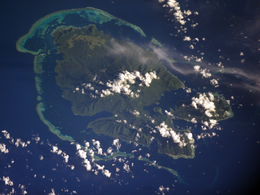Vanikolo Islands

Vanikoro from space. Courtesy NASA
|
|
| Geography | |
|---|---|
| Archipelago | Santa Cruz Islands |
| Area | 173 km2 (67 sq mi) |
| Administration | |
|
Solomon Islands
|
|
| Province | Temotu |
| Demographics | |
| Population | 1300 (2009) |
| Ethnic groups | Melanesian, Polynesian |
Vanikoro (sometimes wrongly named Vanikolo) is an island in the Santa Cruz group, located 118 kilometres (73 miles) to the Southeast of the main Santa Cruz group. It is part of the Temotu Province of the Solomon Islands.
The name Vanikoro is always used as though it referred to a single island, due to both its geophysical and cultural unity. However, technically it is a group of several nearby islands surrounded by a single belt of coral reef. Only the two major islands are inhabited: the bigger one Banie, and the smaller one Teanu (or Tevai). Other, uninhabited islets in the Vanikoro group include Manieve, Nomianu and Nanunga. The total area of the Vanikoro group is 173 square kilometres (66.8 square miles).
The 1300 inhabitants of Vanikoro consist of two different populations, who tend to live separately. The Melanesian majority, about 800 people, are the descendants of the original population of Vanikoro. A minority of about 500 individuals are of Polynesian descent; for the last few centuries they have established settlements on the southern coast of Banie, even though they still preserve close links with Tikopia, an island lying 200 kilometres (124 miles) eastwards, which they identify as their origin.
The three languages spoken by the Melanesian population of Vanikoro are all Oceanic, of the Temotu subgroup:
The Tikopian settlers speak a Polynesian language, Tikopian or fakatikopia.
First sighting by Europeans was in September 1595 by the second Spanish expedition of Álvaro de Mendaña. More precisely it was sighted by Lorenzo Barreto while in command of one of the smaller vessels on a local voyage around the world then called Santa Cruz, which is today's Nendo Island.
...
Wikipedia

